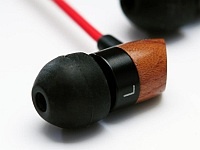-
Nachiket Mhatre
12th Apr 2012
In-ear monitors (IEM) are tiny earphones that go deep into your auditory canal, as opposed to regular earbuds that simply rest at the opening. These IEMs started their life as custom-moulded earpieces meant for musicians and audio engineers, seeking a balance between audio quality and noise isolation during live events. However, their ability to reproduce better detail and, more importantly, attenuate ambient noise to a great degree, has made them a popular choice for portable music players (PMP) that are used outdoors.
An increasing number of mobile phones and PMPs these days tend to ship with IEMs instead of ubiquitous earbuds. Since this earphone type is relatively new, a vast majority of the population fails to use it in the right manner. This not only effectively reduces sound quality, but it can also pose a serious health hazard. If you own an IEM, please take a moment to read this guide to get the best out of your audio setup, and protect yourself from long-term hearing damage.
What Causes Hearing Loss
Before we delve into how to wear your IEMs properly, it's crucial to understand the most common cause for hearing loss with this simple experiment:- Close the doors and windows to reduce ambient noise as much as possible and tune your TV set to an international news channel (avoid Indian ones because they have soundtracks).
- Keep turning the volume down till you can just about comprehend what the news anchor is speaking.
- Note down the volume level and maintain it for five minutes.
- Now switch to a music channel and turn up the volume as much as you can.
- Listen for another five minutes.
- Switch back to the news channel and turn down the volume knob to the same volume level that you had noted earlier.
Can't hear anything now, can you? That's your brain compressing sound levels and attenuating your hearing capability to reduce discomfort, although your eardrums are being subjected to same sound pressure levels (SPL). That's why you need to crank up the headset volume in noisy outdoor environments. But doing so, you unwittingly tend to damage your eardrums with excessive SPL.
Setting The Volume Threshold
The excellent mechanical dampening of ambient noise provided by IEMs is the best solution for this problem. However, you must know how to wear those in the right way to reap their benefits. Before we proceed, it's crucial to set a sound threshold that shouldn't be exceeded under any circumstance.- Go to the quietest corner of your house and close the doors and windows to make it even quieter.
- Turn on auto-volume levelling system in your portable music system if you can. This equalises volume levels between different recordings.
- Choose the loudest and noisiest song and turn up the volume as much as you can comfortably sustain for extended listening, 'comfortably' being the key word here.
- Make a note of the volume level.
Make it a point to never exceed this volume level when you listen to music outdoors. You are left with two possibilities if you have to exceed this threshold of safe hearing. Either your earphones cannot provide enough sound isolation, or the outside noise is unacceptably high. The best thing to do in this case is to stop listening to music altogether.
Safety First
It's a very common and enduring myth that IEMs are harmful due to their proximity to the eardrums. Remember, hearing damage is caused by high SPL and not simply by the virtue of proximity the audio source. On the contrary, IEMs are the safest option for your ears - that is, provided you follow these rules.- Time Out: Let your ears breathe. IEMs do cause an increased production of bacteria in your ear canal. Not that the phenomenon is harmful, but it's a good idea to let your ears rest for a few minutes after every few hours of listening.
- IEM Hygiene: Your body treats the IEMs as a foreign body and therefore produces more wax than usual. Make it a point to regularly clean your IEM and ear canal.
- The Right Fit: When right-sized tips are inserted properly, they provide a better seal, which allows them to be used at lower sound pressure levels (SPL) than any other kind of earphones. Therefore, you don't tend to crank the volume up in a noisy environment.
The last rule is the most crucial and requires a right choice of tips for your IEM. There are three major types of IEM tips - rubber, silicone, and foam tips represented in an ascending order of comfort and cost.
Choosing The Right Tip
 Rubber tips are most likely to cause irritation to those with sensitive skin and these are also a bit harder and less durable. Silicon tips are softer and chemically inert, so they cause minimum discomfort and last much longer. Foam tips are the most comfortable and expand to conform to your ear canal; albeit, at the cost of durability and making the sound more bass heavy. The rubber and silicon tips are further available in multi-flange variants, which provide better sound isolation.
Rubber tips are most likely to cause irritation to those with sensitive skin and these are also a bit harder and less durable. Silicon tips are softer and chemically inert, so they cause minimum discomfort and last much longer. Foam tips are the most comfortable and expand to conform to your ear canal; albeit, at the cost of durability and making the sound more bass heavy. The rubber and silicon tips are further available in multi-flange variants, which provide better sound isolation.The average Indian ear (auditory canal) is smaller than American or European ears. Therefore, it makes little sense to use the default medium-sized tip. Switching to the smallest tip - which works for most Indian ears - is the first thing that you should do. Doing so achieves a better seal, which in turn improves bass and the overall tonality.
Different ears need tips of varying sizes. It's therefore important to try on various sizes and for the best possible seal. A right sized tip allows deeper penetration into the ear canal. This is of utmost importance, because using an oversized tip that doesn't fully enter the canal will make music sound tinny and thin.
How To Wear Your IEM
All of this amounts to nothing if you don't wear your IEM the right way. Here's how:- Identify the left and right channels.
- To wear the right-channel, hold it in your right hand.
- Foam tips should be rolled thin between your palms before insertion.
- Reach over your head with your left hand and pinch the top of your right ear lobe.
- Pull it up and slightly backwards. This straightens the natural curves in your ear canal.
- Open your mouth slightly to expand your ear canal.
- Gently screw in the IEM till you have achieved a perfect seal.
- Lather, rinse, repeat for the other channel.
Get this right and you should immediately hear improved bass response and a marked reduction in external noise. Just make sure your insert and remove the IEMs by twisting them gently. This prevents the air pressure (while inserting) and vacuum (while removing) from putting stress on your eardrum. Happy listening!
Guide: All You Need To Know About Using IEMs Safely | TechTree.com
Guide: All You Need To Know About Using IEMs Safely
Learn how to choose the right earphones and prevent hearing damage.
News Corner
- DRIFE Begins Operations in Namma Bengaluru
- Sevenaire launches ‘NEPTUNE’ – 24W Portable Speaker with RGB LED Lights
- Inbase launches ‘Urban Q1 Pro’ TWS Earbuds with Smart Touch control in India
- Airtel announces Rs 6000 cashback on purchase of smartphones from leading brands
- 78% of Indians are saving to spend during the festive season and 72% will splurge on gadgets & electronics
- 5 Tips For Buying A TV This Festive Season
- Facebook launches its largest creator education program in India
- 5 educational tech toys for young and aspiring engineers
- Mid-range smartphones emerge as customer favourites this festive season, reveals Amazon survey
- COLORFUL Launches Onebot M24A1 AIO PC for Professionals








Reader Comments (19)